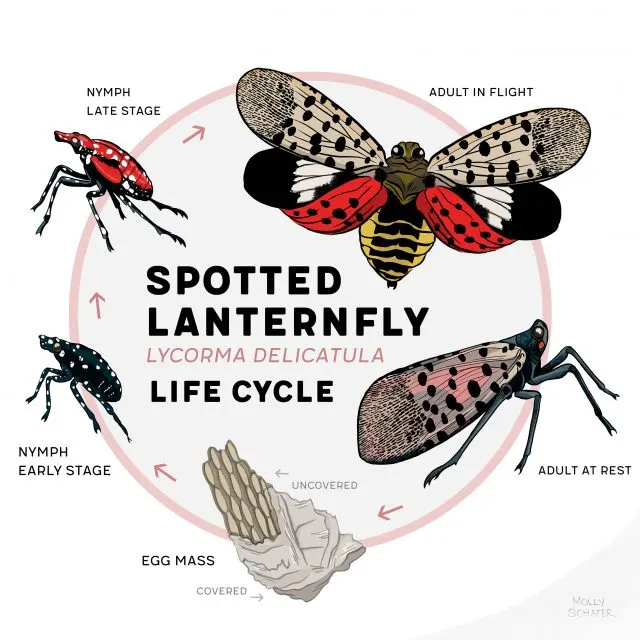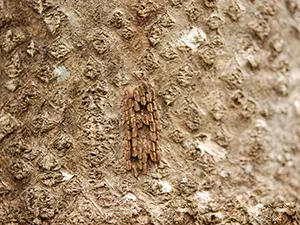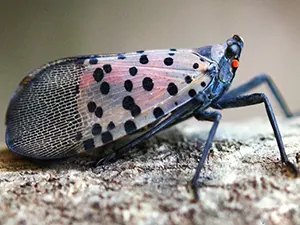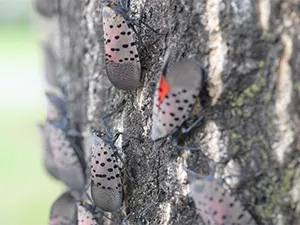HOST PLANTS:
Tree of Heaven, Black Walnut and Grape Vines are preferred hosts, although nymphs are known to attack a wide range of native hardwood and fruit trees. ![]()
DAMAGE:
Spotted lanternfly (SLF) is an invasive planthopper native to Southeastern Asia. The adult insect feeds primarily on the Tree of Heaven a non-native tree. But nymphs are known to attack a wide range of native hardwood and fruit trees. Grape vines are a preferred host of the spotted lanternfly which can attack en masse. If this species continues to establish itself, it could be a formidable threat to various industries (the fruit orchard and grape product industries.)
As the spotted lanternfly was only recently introduced to North America, little is known about the extent of damage that it will cause. Even if SLF does not cause tree mortality, the stress induced from an infestation could weaken a trees defenses, and make it more vulnerable to attack from other insect or pathogen species. In addition, buildup of egg masses and insect secretions (honeydew) can cause damage to patio furniture, garden ornaments, and cars. This insect can also impact the aesthetic value of healthy forests, by causing dark streaks of sap to appear on the bark of impacted trees, and the growth of dark sooty-coloured mold on honeydew secretions.
DESCRIPTION AND LIFECYCLE:
- Eggs: Brown, seed-like, covered in a grey, mud-coloured secretion to form an egg mass arranged vertically.
- Nymph: Four growth phases (instars). Immature nymphs are black with white spots, and as they mature, they become larger. The fourth instar gains red spots with distinctive patches of black and white spots.
- Adult: Wings are approximately 1” long and are grey with black spots. When the wing is open, it has a bright red underwing.
The spotted lanternfly completes its life cycle in one year:
- Eggs hatch into nymphs in spring (April) and enter a cycle of ascendingdescending host trees
- Nymphs ascend trees to feed on leaves and branches, and frequently fall due to environmental conditions (wind), and ascend the tree again
- There are 4 instars of SLF nymphs. After hatching from eggs in April, the nymphs mature through the 4 stages, until they develop into adults in midsummer (July)
- Feeding takes place from April until November
- Feeding preferences change as the insect matures: wide range of host trees as immature nymphs, but specifically target a few species as adults (i.e. Ailanthus and Salix)
- In late summer, adults will mate and lay eggs
- Insects overwinter as eggs within an egg case; adults do not survive through winter.
CONTROL MEASURES:
 Until more is known about this insect and its threat to Ontario and the rest of Canada, management efforts should focus on awareness, education and reporting. This will increase the likelihood of early detection and control of the spotted lanternfly if it arrives here.
Until more is known about this insect and its threat to Ontario and the rest of Canada, management efforts should focus on awareness, education and reporting. This will increase the likelihood of early detection and control of the spotted lanternfly if it arrives here.
Outside of the occasional predation from generalist preditors like praying mantises, yellow jackets, birds, etc. There are no known specialized preditors that will be able to control SLF populations. Lots of work is being done in the US to identify any protential biological controls for SLF.
Tips:
- Do not move the insect or egg masses (check items that are stored outside, such as vehicles, outdoor furniture, picnic tables, planters, boats, children’s play furniture – especially if stored outside under tree of heaven)
- Be on the lookout for egg masses “If you see it, scrape it” – scrape off egg masses into a plastic bag filled with hand sanitizer or rubbing alcohol, seal and throw away.



Reference: Source 1st & 2nd image: Lawrence Barringer, Pennsylvania Department of Agriculture, Bugwood.org 3rd image: Invasive Species Centre https://www.invasivespeciescentre.ca/invasive-species/meet-thespecies/invasive-insects/spotted-lanternfly/
